Time to Rethink the FCTC
- Derek Yach Featured News This Week
- February 20, 2023
- 0
- 19 minutes read

When the World Health Organization drafted the Framework Convention on Tobacco Control (FCTC), global tobacco sales were dominated by combustible cigarettes. The emergence of new technologies, such as e-cigarettes and tobacco-heating products, along with a deterioration in attitudes toward global cooperation have rendered many of the assumptions on which the treaty is based obsolete. During Keller and Heckman’s recent E-Vapor and Tobacco Law Symposium in California, public health expert Derek Yach, who was instrumental in the creation of the FCTC, argued that it is time to update the treaty and bring its stipulations in line with the realities of a radically different context. Below is the text of his presentation, gently edited to fit Tobacco Reporter’s style format.

Active work on the WHO FCTC began with Gro Harlem Brundtland’s appointment as WHO director general in 1998. I was tasked with creating the Tobacco Free Initiative that would develop a treaty to address tobacco control as its primary goal. Substantial work over decades and many resolutions of the World Health Assembly adopted by consensus provided the elements of the treaty. Each element was based on taxes or regulations that were in place in some countries that had contributed to measurable declines in cigarette consumption by 1998. It was the first time the WHO had used its treaty-making provisions provided by the Constitution.
I will briefly reflect on several geopolitical realities that allowed us to make rapid progress on the treaty. I will then highlight several assumptions that governments and academics made at the time about what was needed before considering what is needed now.
Brundtland had been prime minister of Norway and before that minister of health and the environment. She led development of the early round of environmental treaties through the 1980s and 1990s and strongly believed then that multilateralism through the United Nations’ system was the best means to tackle transnational threats to health, the environment and security. Our FCTC advisory team reflected those views and included experts from the worlds of disarmament, diplomacy and international law.
The content of the treaty was supposed to highlight issues of a transnational nature, leaving purely domestic policies for individual countries to decide. Some examples of transnational issues that appeared in the final text included illicit trade (now a protocol), cross-border marketing and scientific exchange. Pretty soon, the negotiations dropped that distinction and included national tobacco control policies that had weak or no transnational dimension. Some examples include tax policies, bans on smoking in public places, cessation programs and youth access initiatives.
The WHO inquiry into the tobacco industry’s decades of so-called “interference” in tobacco control policy and research settings was released early in the negotiating process and served as a constant reminder to governments about the need to address industry interference in policy and research processes.
At the start of the formal negotiations, but separate from the WHO process, several leading multinationals and attorneys general in the United States signed up to the Master Settlement Agreement that imposed penalties on U.S.-based companies and funded a massive nonprofit (the Orwellian sounding Truth Initiative) to tackle youth smoking.
The FCTC reflected these developments and the underlying negative sentiment toward multinationals. Paragraph 5.3 of the FCTC addressing industry interference and the article that addresses litigation against the industry are the best examples of this sentiment. They are unique features of this treaty compared to other UN treaties.
A whole cadre of tobacco control advocates and policymakers were groomed by the FCTC process to follow a set of actions that were felt to be most appropriate at the time. In fact, many called the several FCTC negotiating sessions carried out over a five-year period the “University of Tobacco Control.” Diplomats and health leaders from many countries took part. Few had prior knowledge of tobacco control. Many are still active today. Most have stuck with the “demonize don’t engage” industry mantra. As we will see later, this is because it is the easiest option but not the best option. It requires no intellectual effort.

A Diversion into Adam Grant’s Book, Think Again
Adam Grant is a Wharton professor and noted author. His latest book describes how we are blinded by confirmation and desirability biases. We see what we expect to see, and we see what you want to see. Of course, most people will say, “I’m not biased!” Unfortunately, and to quote Charles Darwin, “ignorance more often begets confidence than does knowledge.” The greater the knowledge, the more likely we acknowledge humility, our doubt and demonstrate curiosity for new insights. Too few people believe what Daniel Kahneman, a Nobel Prize winner for behavioral economics, does. He enjoys discovering he was wrong because it means he is now less wrong than before.
What does this mean for the FCTC today?
I believe that the WHO and leadership of tobacco control are trapped in 1998 thinking and driven by 1970s solutions.
Let me explain the latter first.
Most tobacco control policies were developed in the 1970s and led by a small group of countries: Canada, Norway, New Zealand, the United Kingdom and Singapore. They all had strong regulatory enforcement capacity, elevated levels of local science competence and high levels of education and income. The case studies from these countries formed the basis of global norms. In doing so, the weaknesses within many other countries, especially low-income and middle-income countries (LMICs), in terms of regulatory competence, scientific and medical insights, became impediments to progress.
While physicians led tobacco control policy development and science in the core countries until 2000, this has not happened to a great extent in most LMICs and especially those in Asia, the Middle East and Africa.
Policies have rarely been adapted to the development reality of LMICs. Sitting in Geneva, few understand that “law on the books is not law on the streets.”
Just one example from the WHO’s own review: Cessation services and even nicotine-replacement therapies (NRTs) are not available to most smokers in LMICs. This is despite NRTs having been on the WHO Essential Medicine’s Formulary for years.
All these factors have meant that tobacco control has moved slowly globally—leading the WHO in its latest update (January 2023) to state that by 2025, there will be 1.27 billion tobacco users in the world—a quarter of a billion more than a few years ago. Not a sign of success. The WHO data also shows that smoking rates exceed 50 percent for men in many countries, including Indonesia, China and Jordan.

Two Aspects of 1998 Thinking that Persist Today Despite Profound Changes Underway
Geopolitics has become messy and unpredictable. Paul Tucker describes this in detail in his latest book, Global Discord. Multilateralism as we knew it even a decade ago has eroded fast. The major political and military powers are in a heightened state of tension. Geopolitical threats like pandemics and climate change are not being addressed in the spirit of a common future as was the norm in earlier periods. It is very unlikely that we could have had the degree of agreement negotiated for the FCTC today as was achieved 20 years ago. Brundtland confirmed this was the case in our discussions a few years ago. Going forward, this will have implications for future efforts to update the FCTC or to adjust in the light of new evidence.
The FCTC ignored innovation. The FCTC does not mention intellectual property nor does it tackle the complex issues of patents. Why? Recall that the late 1990s was a period of major activity at the World Trade Organization and the WHO in relation to HIV/AIDS treatments. The question was: How could LMICs access the best treatments at affordable prices? So why is there no focus on innovation, science and modern technologies within the FCTC?
Back then, there was a group sense among the leadership of tobacco control that the tobacco industry was a dirty old legacy industry. They would never innovate their way toward safer and less damaging products. Their last efforts to do this with “lights” were seen as a ruse.
I hosted a meeting of leading tobacco industry scientists and public health experts in the WHO headquarters in 1999 during the negotiations. The aim was to give industry a platform to show whether they had plans to develop truly reduced-risk products. Unfortunately, they did not. No follow-up meetings ever happened.
Article 5.3 in the FCTC got misinterpreted as a rationale to ban engagement with industry—especially their scientists. It was intended to be a warning to government to be vigilant in managing engagement with industry. It addressed common sense conflicts of interest concerns. Since adoption of the FCTC, Bloomberg Philanthropies has invested substantial funding to maintain the view that all industry science cannot be trusted and that so-called industry interference is the biggest threat to progress in ending smoking.
A schism grew and deepened between the companies that have invested billions of dollars in transformative research on the one hand and public health leaders advising the WHO and their governments on how best to end smoking on the other hand.
The U.S. Food and Drug Administration’s $150 million invested recently through the Tobacco Product Scientific Advisory Committee expanded the schism in the U.S. Recall that the U.S. funds 90 percent of all so-called tobacco harm reduction research in the world. U.S. scientists dominate global policy settings and media with their content. Skewed U.S. content skews global debates. How skewed is it?
A content analysis of FDA research spending shows that academics in the U.S., including the American Heart Association, give priority to research that aims to show how dangerous vaping is to kids and, more recently, adults. It scantily addresses the best ways to accelerate an end to adult smoking. It is dismissive of technology innovation—and hence has avoided patent considerations. And it does not attempt to find solutions, for example, for people with schizophrenia or chronic obstructive pulmonary disease (COPD).
In sharp contrast, tobacco and vaping industry research addresses benefits and risks as they are required to by the FDA if they seek authorization of their products to be deemed “appropriate for the protection of public health.”
These two groups of researchers need to engage in scientific debate. Yet opportunities to do so have diminished as journals and conferences have banned scientists funded directly or indirectly by industry. This is leading to a serious bias with implications for public policy. How can we expect to make fundamental change without involving those who hold such a major stake in potential changes? In no other sector—energy, food, pharma—is this tolerated.
While the FCTC remains mute on patents, today, they are a source of intercompany friction and litigation. A recent review of patent filings in China, the U.S. and Europe showed that tobacco harm reduction is one of the most dynamic areas of activity being filed. The review showed that while a small percentage of submissions addressed combustibles, the vast majority were in areas of innovation that are driving safer reduced-risk nicotine products. And a growing number were in areas of pharmaceutical and medical applications.
This fundamental shift by leading tobacco companies to invest in solutions for health has been joined by newer and often smaller separate vape, synthetic nicotine, inhalant and related companies. Entrepreneurs backed by investors are now highly active in this space.
The industry is moving toward a world where nicotine, freed from its damaging links to tobacco, could end millions of tobacco deaths and, in time, prevent a range of neurological and brain disorders associated with aging.
Grant’s call for us to rethink in the light of new realities applies directly to our field.
Grant’s call for a rethink applies to our leading public health agencies. And some progress is underway. The Reagan-Udall Foundation review of the FDA is a good start. The recent Center for Strategic and International Studies’ review of the Centers for Disease Control and Prevention (CDC) and the Lancet Commission and other reviews of the WHO all represent a chance to take a fresh look at how agencies failed to yield the desired results during the pandemic. Sadly, many of these agencies and their leaders are characterized by the opposite of rethinking. This is well summarized in a wonderful-sounding word: mumpsimus, or “a person who obstinately adheres to old customs or ideas in spite of evidence that they are wrong or unreasonable.”
Last month, the WHO’s executive board reviewed progress in tackling global health. Its conclusion was that we are wildly off track in terms of reaching agreed goals for cancer, heart disease, lung disease and mental health. The worst pandemic in a century has played a key role in these trends. More of the same will not get us back on track. It’s time the WHO recognized that technology and innovation, led by private sector innovation, is the fastest way to make progress. They know that to be the case for most of biomedicine.
Embracing tobacco harm reduction represents such innovation in our sector. It is the only way to cut tobacco deaths within a decade or so. And it is consistent with the FCTC. Recall that the very definition of tobacco control includes “tobacco harm reduction.” Article 1(d) of the FCTC explicitly states that “tobacco control” means a range of supply, demand and harm reduction strategies that aim to improve the health of a population by eliminating or reducing their consumption of tobacco products and exposure to tobacco smoke.” Unfortunately, these “harm reduction strategies” have never been elaborated and defined. One could argue that this has led and will continue to lead to unnecessary tobacco-related disease and premature death.
Governments are being encouraged and supported to ban or restrict many products that could cut deaths and disease. This is not acceptable. The science has strengthened in favor of vapes, nicotine pouches, snus and heated-tobacco products. The FDA authorizations of these products start with them passing the FDA test as being “appropriate for the protection of public health.”

What are the Components of a Rethink?
- The WHO should acknowledge the imperative to tackle the health of adults who smoke as the main way it can get global health sustainable development goals on track. Most adults who have early COPD stage or cardiovascular disease or pre-cancerous signs of oral cancer or schizophrenia or tuberculosis are smokers. That is why people with schizophrenia die 10 years to 15 years younger than the general population—a fact ignored by most policymakers. Well over half of all patients with COPD smoke at diagnosis, and 90 percent smoke a year post diagnosis. A true failure of health systems.
- The WHO should appoint an independent commission to have the same terms of reference the British government gave to Javed Kahn. Define better ways to end smoking by 2030. And this should be in part funded by Michael Bloomberg’s latest grant to strengthen tobacco control. There is no loss of face in doing this. Simply a recognition that the science has advanced and policy needs to catch up. Article 5.3 assumed that there is an “irreconcilable difference between the interests of public health and the tobacco industry.” That was true in 1998. Today, the reality is more complex. The FDA deeming of reduced-risk products as being “appropriate for the protection of public health” calls into question the continuation of the irreconcilable conflict principle and suggests more nuance is required about who, how and when to engage. A commission is required to explore this new reality.
- The negotiations on a pandemic treaty have just started in Geneva. The central focus is on solidarity and equity. In the draft zero that was just released, 11 of the 49 paragraphs deal in some way with intellectual property and related issues like strengthening national research capacity. A few years ago, I asked a CEO of a leading tobacco company if he would consider licensing some of their most important innovations to companies in LMICs or state monopolies to help them accelerate their exit from combustibles. He gave an emphatic yes. It is time we pushed leading multinationals to do this.
- Governments that include harm reduction in their tobacco control programs or have solid evidence of the contribution harm reduction plays to their decreased smoking rates should actively share their experiences with governments during the World Health Assembly and at the upcoming FCTC Conference of the Parties in Panama later this year. More specifically, the U.S. government’s FDA representative should outline the rationale and progress made in authorizing several snus, vape, nicotine pouch and heated-tobacco products. The world’s most sophisticated regulatory body has decided harm reduction products benefit smokers but has done nothing to share this knowledge globally. This is exactly the opposite of what it does in relation to new drugs, vaccines or health interventions unrelated to tobacco. There is a little-known amendment to an appropriation resolution going back decades, the Doggett Amendment, which compels U.S. embassies around the world to not provide support to U.S. tobacco companies in foreign countries. The FDA authorizations now demand that this be adjusted to permit and encourage embassies and companies with authorized products to explain their benefits to health and science leaders around the world. The Chinese government holds the key to full transformation of the global tobacco industry. Its state monopoly sells more than half of all cigarettes sold worldwide, and this percent is increasing. To date, it has been slow to adopt tobacco harm reduction despite being the home to the most innovative e-cigarette and related technology companies in the world. Two years ago, the government announced a goal of having all new car sales in 2035 be electric vehicles. Imagine the power of a similar commitment to end combustibles.
- Over the last decade, leading tobacco multinationals have made progress in getting a range of reduced-risk products to market. In some cases, revenue from such products is approaching 50 percent of total revenue. The recent report from the Foundation for a Smoke-Free World shows, however, that little progress has been made in LMICs where reduced-risk products are legal. BAT has made the most progress with its reduced-risk products now available in Egypt, Indonesia, Pakistan and Saudi Arabia, among others; PMI sells in Saudi Arabia, Egypt and the Philippines. Other multinationals are absent from most of these countries, and no multinational sells in Nigeria or Bangladesh. Note that 80 percent of all smokers reside in LMICs, and a similar proportion of deaths from tobacco occur there. Industry could do more, faster and through partnerships with state monopolies and smaller companies.
- Tobacco and vape companies need to urgently prepare submissions for medical licensing of vapes and nicotine pouches. The FDA and the U.K. Medicines and Healthcare products Regulatory Agency have called for this. It could reverse the increasing resistance of the health professionals to these products—opening the door to wider use with major population health gains.
- It’s time we took on disinformation within tobacco harm reduction more seriously. In February, FDA Commissioner Robert Califf called for urgent action related to Covid-19 misinformation. It’s time the FDA tackled massive disinformation related to tobacco harm reduction. I am sure he knows—as you know; as FDA tobacco chief Brian King knows; as 15 past presidents of the Society for Research on Nicotine and Tobacco know—that nicotine is not the problem or the cause of cancer. But despite this, the CDC, the Campaign for Tobacco-Free Kids, the WHO and, yes, the FDA fund campaigns that propagate false, misleading and deceptive messages about harm reduction and nicotine. The stream of retractions of fake science they cite grows. Vaping does not cause cancer or heart disease or e-cigarette or vaping product use-associated lung injury (EVALI.) The original lies, though, live on in policy briefs worldwide and are seen by many as fact.
Kahneman inspired Grant to remind us that it is much easier to follow in the paths of the status quo. For the sake of global health, it is time we took the path least taken—to real progress.

